
This is a list of properties and historic districts in Kentucky that are listed on the National Register of Historic Places. There are listings in all of Kentucky's 120 counties.

The Southport Historic District in the town of Fairfield, Connecticut is a 225-acre (91 ha) area historic district that was listed on the National Register of Historic Places in 1971. It preserves a portion of the modern neighborhood and former borough of Southport, Connecticut. Since the British burnt almost all of Southport's structures in 1779, there is only one home built prior to that date, the Meeker House at 824 Harbor Road, which survives.
Allenhurst, also known as Oakland, is an historic site located in Scott County, Kentucky west of Georgetown on Cane Run Pike. The Greek Revival house, designed by Thomas Lewinski, was built in 1850. The property was added to the U.S. National Register of Historic Places on April 2, 1973.

The Shropshire House is a Greek Revival Federal style house located in the East Main Street Residential Historic District in Georgetown, Kentucky. The house was the built in 1814 by John and Mary (Gano) Buckner. The property was added to the U.S. National Register of Historic Places on April 2, 1973.
The John Andrew Miller House is a house built by an early Kentucky settler in the eastern area of Scott County, Kentucky when it was still a part of Virginia. The house is located off of Paris Pike between the city of Georgetown and the town of Newtown. The property was added to the U.S. National Register of Historic Places on November 9, 1977.

The Johnston–Jacobs House is a Greek Revival style brick house located near downtown Georgetown, Kentucky. The original structure was built in approximately 1795 by Adam Johnston for use as a tavern-inn. The property was added to the U.S. National Register of Historic Places on October 2, 1973.
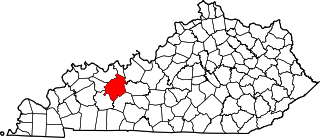
This is a list of the National Register of Historic Places listings in Ohio County, Kentucky.
The Keene Springs Hotel is a rambling wood-frame, two-story Greek Revival-style building built in sections in 1841 by Mason Singleton, Jr. in the hamlet of Keene, near Nicholasville, Kentucky in Jessamine County. He and his wife Nancy owned and operated the hotel and tavern as a resort destination for the white sulphur springs nearby. During the cholera epidemic of 1848–1849 and outbreaks in the early 1850s, residents of Lexington came to the hotel to try to escape the spread of disease in the city. The Singletons operated the hotel until 1857, when they sold it to Alfred McTyre.
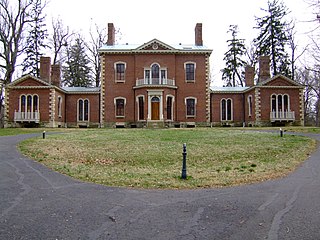
Thomas Lewinski was an architect in Kentucky, United States. Born in England, he immigrated to the United States. For his work at Allenhurst and elsewhere, Lewinski was known in his day as one of the leading architects of the Greek Revival style. He designed many architecturally significant buildings that survive and are listed on the United States National Register of Historic Places.
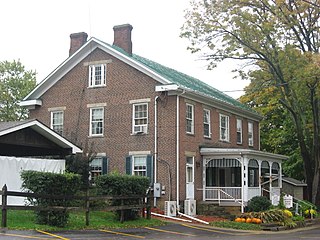
Inn at Fowlerstown, also known as Drover's Inn, is a historic hotel located near Wellsburg in Brooke County, West Virginia, United States. The inn was built between 1848 and 1851, and is a 2½-story brick building in the Greek Revival style. The property also includes a two-story log house (1820) and frame cottage that pre-date the inn. Contributing outbuildings are a small clapboard well house, chicken coop, and privy. Before 1938, the inn housed a general store and post office that served the small village of Fowlerstown. The village grew up around along Washington Pike at the grist mill established by William Fowler.

Mooreland is a property in Brentwood, Tennessee that was built c.1838 and that was listed on the National Register of Historic Places in 1975.

Mountview is a property in Brentwood, Tennessee that was built in 1860 and that was listed on the National Register of Historic Places in 1986. It has also been known as the Davis-Rozelle Residence.
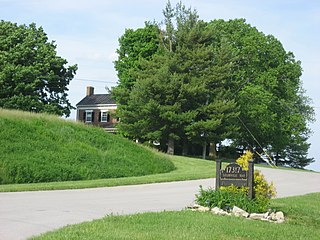
Simeon Moore House, also known as Cane Run Farm, is a historic house and farmstead located along Cane Run on Taylorsville Road, near Fisherville, Kentucky. It was listed on the National Register of Historic Places in 1980.

The Lyme Center Historic District encompasses a modest crossroads and industrial village in rural Lyme, New Hampshire. The predominantly residential district stretches along Dorchester Road, on either side of its junction with Baker Hill Road. The village's rise in development started in the early 19th century as it was at a crossroads of the east-west Dorchester Road, and the north-south Baker Hill Road and Acorn Hill Road. The village grew rapidly in the 1820s, with a number of simple Greek Revival houses, and in 1830 the Baptist Church was built. The other major civic building in the village is the Lyme Academy, built in 1839, albeit with more Federal than Greek Revival styling. Grant Brook, which runs parallel to Dorchester Road, provided a source of power for the growth of small industrial efforts, including a sawmill at the corner of Dorchester and Baker Hill Roads. This industry provided a second minor building boom in the late 19th to early 20th century. Most of the houses in the district are vernacular Greek Revival or Cape in their styling; probably the most elaborate Greek Revival house is the 1857 Beal-Pike House at 41 Dorchester Road.
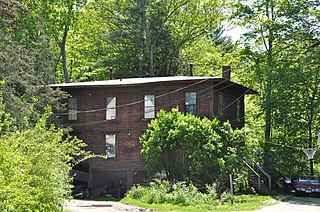
The Amos Chase House and Mill are a historic property on New Hampshire Route 114, just south of the Piscataquog River in Weare, New Hampshire. The mill, built about 1849, is the last 19th-century mill standing in Weare, and the house, built about 1836, is a good example of vernacular Greek Revival architecture. The property was listed on the National Register of Historic Places in 1992.

The Asbury Historic District is a 288 acres (117 ha) historic district encompassing the community of Asbury in Franklin Township of Warren County, New Jersey. It is bounded by County Route 632, County Route 643, Maple Avenue, Kitchen Road, and School Street and extends along the Musconetcong River into Bethlehem Township of Hunterdon County. It was listed on the National Register of Historic Places on March 19, 1993 for its significance in architecture, industry, religion, community development, politics/government, and commerce. The district includes 141 contributing buildings, a contributing structure, two contributing sites, and four contributing objects.
The Brents-Lisle House, near Greensburg, Kentucky, was listed on the National Register of Historic Places in 1984.

Pleasant Valley is an unincorporated community located in Washington Township, Warren County, New Jersey, west of Washington, along the Pohatcong Creek. The hamlet was built around a mill on the creek during the mid-18th century. The Pleasant Valley Historic District, encompassing the village, is listed on the state and national registers of historic places.

Franklin Corners is an unincorporated community located along the Passaic River at the intersection of County Route 613 and U.S. Route 202 in Bernards Township of Somerset County, New Jersey. In the 19th century, it had a grist mill, saw mill, general store, school, and several houses. The Franklin Corners Historic District, featuring Van Dorn's Mill, was listed on the National Register of Historic Places in 1975.
















